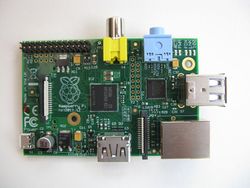UP-FM Transmitter: Difference between revisions
mNo edit summary |
|||
| Line 2: | Line 2: | ||
==DESCRIPTION== | ==DESCRIPTION== | ||
A Raspberry PI-based program FM transmitter that plays online UP-FM music radio. Radio receivers can tune in to 87.5MHz if the transmitter is in range. | A Raspberry PI-based program FM transmitter that plays online [[UP-FM]] music radio. Radio receivers can tune in to 87.5MHz if the transmitter is in range. | ||
Individuals from the different UP campuses, UP alumni and friends in different locations, lovers of Filipino indie music are encouraged to build and use this device to broadcast UP-FM in their areas. | Individuals from the different UP campuses, UP alumni and friends in different locations, lovers of Filipino indie music are encouraged to build and use this device to broadcast UP-FM in their areas. | ||
| Line 37: | Line 37: | ||
*You will now program the PIfm in Raspberry PI. First you must have an SD card with Raspbian "wheezy" OS. | *You will now program the PIfm in Raspberry PI. First you must have an SD card with Raspbian "wheezy" OS. | ||
<br/> | |||
==See Also== | |||
* [[UP-FM]] | |||
<br/> | <br/> | ||
<br/> | |||
[[Category:DILC Projects]] | |||
Revision as of 20:07, 23 April 2014
DESCRIPTION
A Raspberry PI-based program FM transmitter that plays online UP-FM music radio. Radio receivers can tune in to 87.5MHz if the transmitter is in range.
Individuals from the different UP campuses, UP alumni and friends in different locations, lovers of Filipino indie music are encouraged to build and use this device to broadcast UP-FM in their areas.
SPECS
COMPONENTS
a. For PIFM:
- Raspberry PI (model B)
PROCEDURES
A. Making a Simple Antenna:
- Since you may not have an ideal antenna, you will use a solid wire (no.22) as substitute. Cut a solid wire about 32 centimeters and stripe one end at least 1 cm. Also cut the GPIO cable wire near the socket and leave at least 1 cm wire on it. Stripe the wire near the GPIO socket. Combine both ends of the solid wire and GPIO socket using lead and soldering iron. Wrap the soldered wire and GPIO with the tape (see picture below).
B. Programming the PIfm:
- You will now program the PIfm in Raspberry PI. First you must have an SD card with Raspbian "wheezy" OS.
See Also















